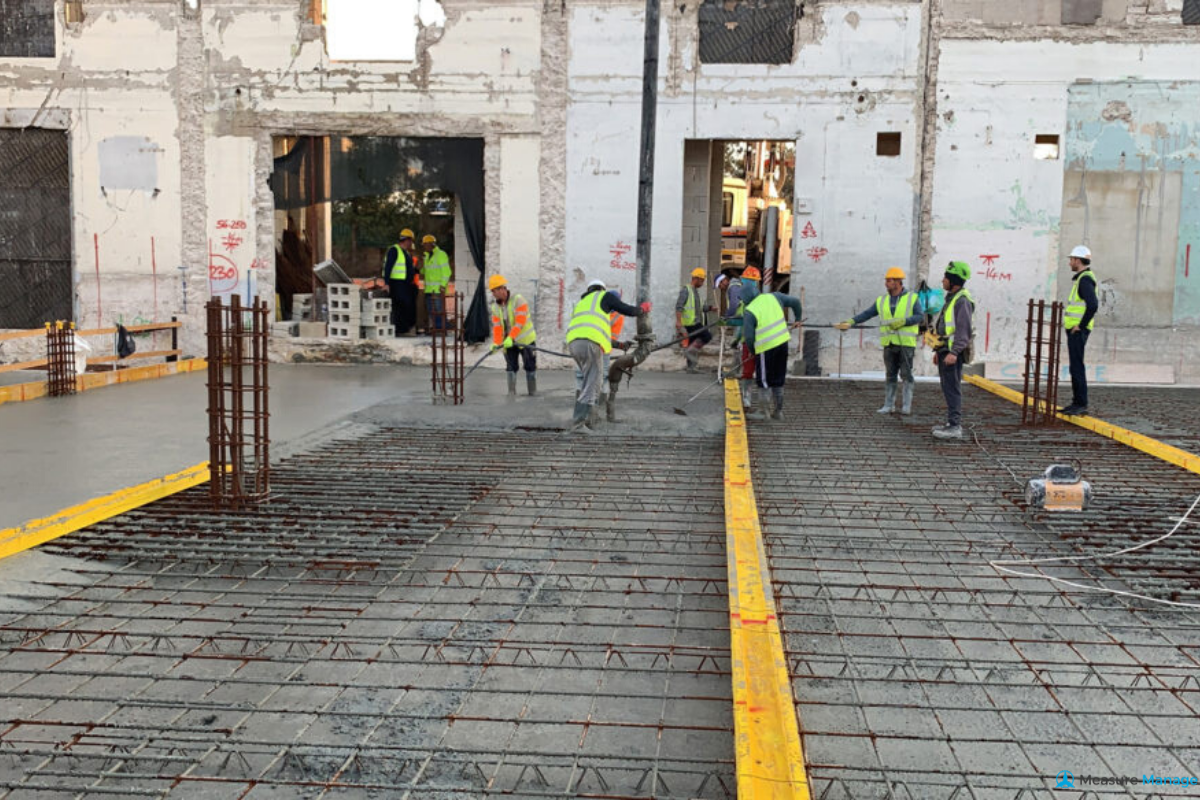In this blog we explain how to easily waterproof colored concrete, cement and mortar. Ecoform Europe itself does not sell dyes for cement, but products for waterproofing cement and concrete.
Create simple colored
Concrete, Cement and Mortar
Is it possible to make colored cement? Or colored concrete? Yes, there are excellent solutions for mixing any desired color of cement or concrete. You can read how this works here. And the best part is that we can also make the colored concrete or cement waterproof. Colored and waterproof concrete provides wonderful possibilities for your home, interior and garden.
The Standard Color of Concrete, Cement and Mortar
Cement is gray by default. Cement gray even a standard color in the well-known RAL color system (RAL 7033 Cement gray, Cement gray or cement gray). But what do we actually mean by ‘cement’? Because that term often creates confusion. You regularly hear that bricks are bricked with cement when that is actually not correct.
Masonry mortar is used for bricklaying and indeed this mortar contains cement, but also masonry sand (in the ratio 1: 3) that is prepared with water. Concrete also consists of cement, with sand and gravel added (in the ratio 1: 2: 3), and of course also water. Cement is the binder in both types of mortar and provides the characteristic gray tint. Incidentally, there is also white cement that is produced by using iron-free raw materials and grinding the product longer.
White or Colored Cement or Concrete
White colored cement or concrete is used regularly – even if it is more expensive than gray – for aesthetic reasons. Where the gray cement or concrete color makes a structure naturally gray and less beautiful, white gives a much more beautiful appearance. Because concrete and cement are less and less ‘covered’ nowadays and are playing a more prominent role in architecture, the interior and the garden, such a fresh white color is of course very attractive. But
if we really want to make full use of the attractive structure of concrete and masonry, we also want to use other colors of cement. Fortunately, that is now possible.
How do you Make Colored Concrete and Masonry Mortar?
As mentioned, mortar for concrete or masonry mortar is made by mixing cement with sand and possibly gravel in certain proportions. We cannot – or very difficult – change the color by adding the right types of sand and stones. We have roughly had the options with gray or white. Fortunately, there is also dye. There are different types of cement dye , such as Weber cement dye and SikaCim Color . By adding these dyes to the mortar, we can give cement and concrete almost any color we want. Thanks to cement dye, we obtain color-resistant masonry mortar and concrete.
Adding cement dye, including Sakrete Mortel dyeis very simple. First, the ordinary dry substances of the mortar are mixed (cement, sand and possibly gravel). Of course you can also buy ready-made bags of mortar. Then add between 2 and up to 5 percent of the original mortar weight of dye. Do not use more than that percentage.
Mortar derives its strength and binding strength from the original composition and becomes weaker if we add too many fillers (such as colorant). Incidentally, ready-made mortar is also available to which cement dye has already been added. The colored mortar is mixed with water and can then be used for all possible applications. From colored masonry, jointing and concrete walls to colorful screeds, garden objects and plaster layers.
How do You make the Right Color of Concrete or Mortar?
This is the most difficult aspect. In the production of mortar, all kinds of natural color differences are naturally caused by the raw materials. The way in which the same mortar is processed, the formwork used and conditions during drying and hardening also influence the final color. It is therefore not possible to perfectly predict the color of the concrete or cement. The dyes used are of course accurately specified (and available in many variants), but the final cement or concrete color depends on the above factors.
So working with dye requires some experimentation. For example, you can make a number of test trays with varying percentages of dye to determine the correct amount for your specific application. Make sure to note the chosen composition. Or create enough mortar in one go to prevent later color differences. Incidentally, for beautiful bright colors it is sometimes advisable not to work with standard gray cement, but with white cement. On that white base, the cement colors stand out most clearly.
You can also paint Concrete, Right?
Yes, there is concrete paint with which you can paint gray concrete or cement in a different color. But while dye colors the concrete through and through – and that color no longer goes out – concrete paint only refers to a painted surface. It wears, damages or discolours and must be re-treated over time. The effect is less attractive than when using dyes. With existing concrete or masonry, paint is of course the only option. It is no problem to coat over a concrete floor treated with Per Macon or give a different kind of finish.
Also, Read This: How to Hire a Reliable Structural Engineer?
Is my colored cement or Concrete waterproof?
CEMENTMIX NOW!
Not simply. Like ordinary mortar, cement or concrete with a colorant is not automatically watertight. The material is porous and can absorb water. However, because we add the dye when preparing the mortar or concrete, we can also make the mortar waterproof at the same time.
MM supplies Cementmix with which both masonry mortar and concrete are made completely waterproof . Replacing the water with the same amount of liquid cement mix during the mixing process creates watertight concrete. In the same way, we can make waterproof colored concrete or masonry mortar. In that case, we first mix the desired amount of dye into the mortar.
After which the dry, colored mortar is prepared for use with Cementmix. The colored concrete or masonry mortar is completely waterproof after processing and curing.




